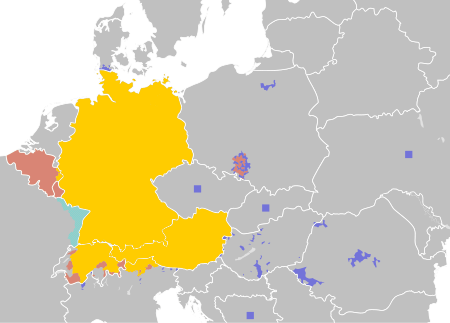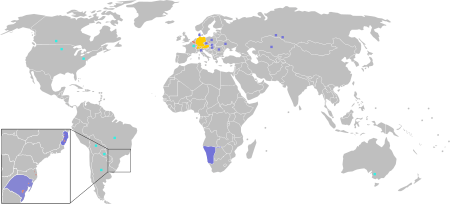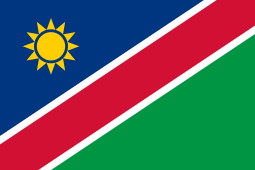List of territorial entities where German is an official language
The following is a list of the territorial entities where German is an official language. It includes countries which have German as (one of) their nationwide official language(s), as well as dependent territories with German as a co-official language.

Approximate distribution of native German speakers (assuming a rounded total of 95 million) worldwide.
German as an official language
German is the official language of six countries, all of which lie in central and western Europe. These countries (with the addition of South Tyrol of Italy) also form the Council for German Orthography and are referred to as the German Sprachraum (German language area).
| Country | Population [1] |
Speakers | Notes | |
|---|---|---|---|---|
| (native)[2][3][4] | (second)[2][4] | |||
| 84,900,000 | 75,101,421 (91.8%) | 5,600,000 (6.9%) | De facto sole nationwide official language[lower-alpha 1] | |
| 11,420,163 | 73,000 (0.6%) | 2,472,746 (22%) | De jure official language in the German speaking community | |
| 8,838,171 | 8,040,960 (93%) | 516,000 (6%) | De jure sole nationwide official language | |
| 8,508,904 | 5,329,393 (64.6%) | 395,000 (5%) | Co-official language at federal level; de jure sole official language in 17, co-official in 4 cantons (out of 26) | |
| 11,000 (2%) | 380,000 (67.5%) | De jure nationwide co-official language | ||
| 37,370 | 32,075 (85.8%) | 5,200 (13.9%) | De jure sole nationwide official language | |
| Total | 112,238,899 | 87,875,432 | 9,368,946 | Total speakers: 97,244,378 |
Dependent entities
German, or one of its dialects, is a co-official language in several dependent entities. In each of these regions, German, along with the official language of the host nation, is an official language on the administrative level.
| Region | Country | Population 2006/2011 |
Native speakers |
Notes |
|---|---|---|---|---|
| 511,750 | 354,643 (69.3%)[5] | Co-official language on province level; equal to Italian | ||
| 250,000 | ~50,000 (~20%)[6] | Auxiliary language in 31 communes;[7] also national minority language[8] | ||
| 205,000 | N/A | Co-official language in 9 municipalities[9] (as "German", "Pomeranian", and "Hunsrückisch"); also statewide cultural language in Espírito Santo;[10][11] Riograndenser Hunsrückisch German is an integral part of the historical and cultural heritage of Rio Grande do Sul.[12] |
In the two Slovak villages of ![]()
![]()
Other legal statuses

There are other political entities (countries as well as dependent entities) which acknowledge other legal statuses for the German language or one of its dialects. While these may cover minority rights, support of certain language facilities (schools, media, etc.), and the promotion of cultural protection/heritage, they do not encompass the establishment of German as an "official" language, i.e., being required in public offices or administrative texts.













Although in ![]()
The constitution of ![]()
Due to the German diaspora and Russian Mennonites (speaking Mennonite Low German), other countries with sizable populations of (mostly bilingual) German L1 speakers include ![]()
![]()
![]()
![]()
![]()
![]()
International institutions
German is an official language of the following international institutions:
- European Patent Organisation – EPO
- European Space Agency – ESA
- European Union - EU
- Organization for Security and Co-operation in Europe - OSCE
- Reporters Without Borders – RWB
- World Association of Newspapers – WAN
- Numerous international sports associations:
- European Handball Federation – EHF
- Fédération Internationale de Basketball – FIBA
- Fédération Internationale de Bobsleigh et de Tobogganing – FIBT
- Fédération Internationale de Football Association – FIFA
- Fédération Internationale de Gymnastique – FIG
- Fédération Internationale de Luge de Course – FIL
- Fédération Internationale de Ski – FIS
- International Biathlon Union – IBU
- Union of European Football Associations – UEFA
Notes
- While several specific laws, e.g., §23 VwVfG or $184 GVG, specify German as the administrative language in Germany, the Grundgesetz does not specifically mention it as federal official language.
References
- See: List of countries and dependencies by population
- Eurobarometer 2012 - Annex
- "German, Standard". Ethnologue.
- Ammon, Ulrich (November 2014). "Die Stellung der deutschen Sprache in der Welt" (in German) (1st ed.). Berlin, Germany: de Gruyter. ISBN 978-3-11-019298-8. Retrieved 2015-07-24.
- Census of South Tyrol 2011
- Polish census 2011 (note that ethnic associations allow only for a very rough estimate of first language distribution)
- "Map on page of Polish Commission on Standardization of Geographical Names" (PDF). Retrieved 20 June 2015.
- Council of Europe - List of ratifications of the Charter for regional/minority languages
- "IPOL realizará formação de recenseadores para o censo linguístico do município de Antônio Carlos-SC". e-ipol.org.
- Legislative Assembly of the state of Espírito Santo (Commissioner for Culture and Social Communication - Addition to the constitutional amendment number 11/2009 establishing the Pomeranian dialect as well as German as cultural heritage of the state (February 2011)
- Plenário aprova em segundo turno a PEC do patrimônio
- Lei N.º 14.061, de 23 de julho de 2012
- Úrad splnomocnenca vlády SR pre národnostné menšiny (The Government Council of the Slovak Republic for National Minorities and Ethnic Groups) - List of Slovakian municipalities with >20% minority population (2011)
- National Geographic Collegiate Atlas of the World. Willard, Ohio: R.R. Donnelley & Sons Company. April 2006. pp. 257–299. ISBN 978-0-7922-3662-7.
- "Annual of Language & Politics and Politics of Identity - Language Policy of Slovak Republic (Zdeněk Škrobák)" (PDF). Archived from the original (PDF) on 2014-07-26. Retrieved 2015-06-23.
- "National Council of the Slovak Republic - 184 Act (dated 10 July 1999) on the use of languages of national minorities". kbdesign.sk.
- Carolin Zwilling (European Academy Bolzano-Bozen, 2004) - Minority Protection and Language Policy in the Czech Republic
- "European Centre for Minority Issues - Bonn-Copenhagen Declarations". ecmi.de. Archived from the original on 2016-10-14. Retrieved 2015-06-23.
- Die deutsche Minderheit in Dänemark - Sprache – Identität und Schlüssel (German). Letzter Zugriff am 3. Mai 2015
- "Deutsche Botschaft Budapest - Die deutsche Minderheit in Ungarn". Archived from the original on 5 May 2015. Retrieved 3 May 2015.
- Ministry of Foreign Affairs, Budapest - The national and ethnic minorities in Hungary
- "Tutela delle comunità linguistiche storiche – Provincia Autonoma di Trento – Minoranze Linguistiche". provincia.tn.it.
- Sprachminderheiten in Italien - Autonome Region Trentino-Südtirol
- L.R. n. 26 del 10 aprile 1990 - Tutela, valorizzazione e promozione della conoscenza dell'originale patrimonio linguistico del Piemonte - B.U. n. 16 del 18 aprile 1990
- Loi constitutionnelle n° 4 du 26 février 1948 STATUT SPECIAL POUR LA VALLEE D'AOSTE
- Sprachminderheiten in Italien - Friuli Venezia Giulia
- "German as recognized language in Kazakhstan according to Language Law, No. 151-1, 11 July, Articles 4,6,7 (1997)". Ethnologue.
- "Deutsch in Namibia" (PDF) (in German). Supplement of the Allgemeine Zeitung. 18 August 2007. Archived from the original (PDF) on 24 June 2008. Retrieved 23 June 2008.
- "Die deutsche Sprache in Deutschland, Österreich und der Schweiz". google.de.
- "УСТАВ АЗОВСКОГО РАЙОННОГО СОВЕТА ОТ 21.05.2002 N 5-09 УСТАВ МУНИЦИПАЛЬНОГО ОБРАЗОВАНИЯ "АЗОВСКИЙ НЕМЕЦКИЙ НАЦИОНАЛЬНЫЙ РАЙОН ОМСКОЙ ОБЛАСТИ (ПРИНЯТ РЕШЕНИЕМ АЗОВСКОГО РАЙОННОГО СОВЕТА ОТ 21.05.2002 N 5-09, ЗАРЕГИСТРИРОВАН ПОСТАНОВЛЕНИЕМ ЗС ОТ 25.06.2002 N 106)". bestpravo.com. Archived from the original on 2016-08-08. Retrieved 2016-04-27.
- "Charte européenne des langues régionales : Hollande nourrit la guerre contre le français". Le Figaro.
- "Constitution of the Republic of South Africa, 1996 - Chapter 1: Founding Provisions". www.gov.za.
- German L1 speakers outside Europe